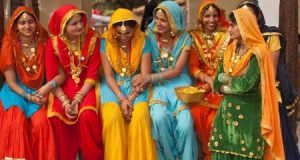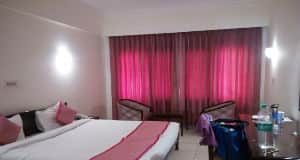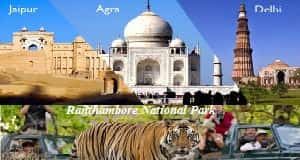Gujarat Wildlife & Birdwatching Tour
Gujarat, a state located in the western region of India, is known for its spiritual significance and its active participation in preserving wildlife. This state’s unique culture has attracted millions of visitors every year to witness the abundance of rare wildlife species roaming free. The Gir National Park, located in Gujarat, is home to 400 endangered Asiatic lions, a species that cannot be found anywhere else in Asia. Additionally, the Rann of Kutch, a captivating white desert, is a dream destination for many millennials who yearn to explore it at least once in their lifetime.
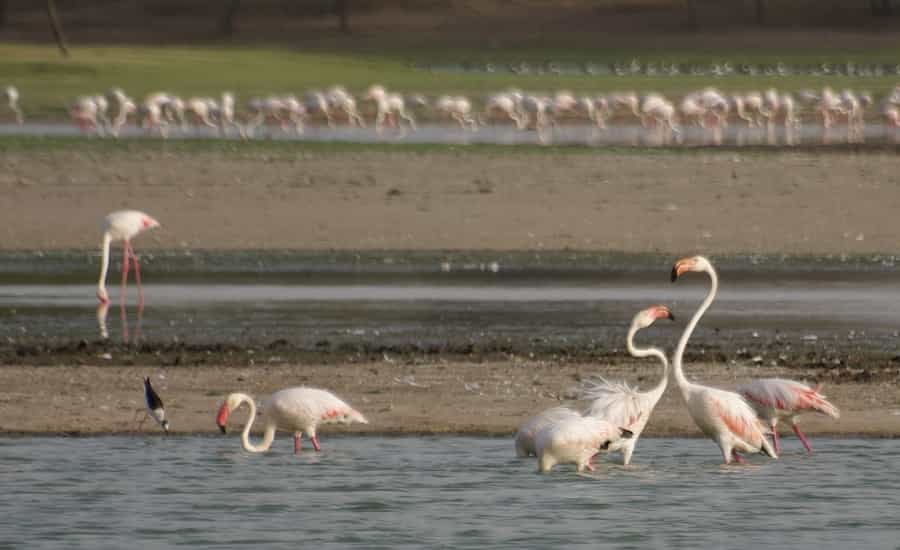
- Tour Days: 13 Days – 12 Nights
- Destinations: Delhi, Ahmedabad, Dasada, Rann, Jamnagar, Gondal, Sasan, Palitana, Velavadar National Park, Ahmedabad
Tour Itinerary
Day 1: Delhi
Meeting & assistance upon arrival at Delhi airport and then transfer to the hotel. Overnight at the Hotel.
Day 2: Delhi – Ahmedabad – Dasada (Two hours + birding stops)
Highlights: Little Rann of Kutch
Arrive at Ahmedabad by morning flight. Meeting and assistance at Ahmedabad airport, then drive to Dasada, a two-hour drive. On the way, we will check out the cattle graveyards for vultures and lakes where resident species (including sub-continent endemics) like Openbill Stork, Nakta Comb Duck, Spotbill, Sarus Cranes, etc are possible sightings.
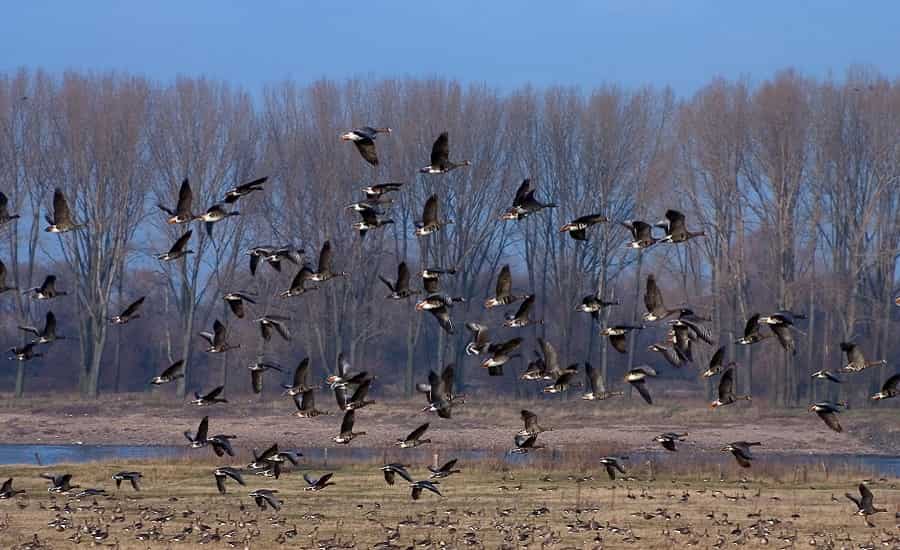
We will arrive at the resort in time for lunch. This eco-friendly resort is imaginatively designed using local materials to resemble a local village and has cottages with long wicker-beds, writing table, a dressing room and modern tiled bathroom. The huge campus of the resort has ponds visited by pelicans, kingfishers, Grey and Indian Pond Herons, and Black Ibis. In the gardens there are often Yellow-footed Green Pigeons, Bluethroats, Shikras and other birds. They have their own agricultural fields and plantations, which are good for larks, pipits and wheatears.
Afternoon drive in the Little Rann of Kutch in open-topped 4WD vehicles. This is a sanctuary for the endangered Asiatic Wild Ass. The Wild Ass sighting is almost guaranteed and Nilgai and Blackbuck Antelope, Chinkara (Indian Gazelle), Indian and Desert Foxes, Jackal and Gerbille are possible. The Indian Wolf can be seen if we are lucky. The Rann is good for larks, Desert and other wheatears, Desert Warblers, quails and Button-quails, Chestnut-bellied and Spotted Sandgrouse. There are also good chances of seeing MacQueen’s Bustard. In the evening, it is possible to see Aquila Eagles and harriers coming in to roost on open-ground. Overnight at Rann Riders.
Day 3: Little Rann of Kutch
Early morning drive to the `Bets’ in the Little Rann of Kutch. These were probably islands when the Rann was part of the Arabian Sea. The Bets are highlands rising over the saline desert plains. MacQueen’s bustard sighting is likely and a selection of 13 species of larks (including Sparrow-larks) can be seen.
Return for breakfast and then walk in Dasada Village, where Yellow-footed Green Pigeon and other birds can be seen around the local lake. Those interested in handicrafts, can look at embroidery and silk-weaving as well. After lunch and rest, we depart for a drive to a wetland area in the Little Rann of Kutch. Greater and Lesser Flamingos, Sarus, Demoiselle and Common Cranes, Black-headed and Glossy Ibis, Painted and Openbill Stork, Spoonbill, Greylag and Bar-headed Geese, Purple Swamphen, Indian Moorhen, Grey and Purple Herons, Ruff and various pelicans, sandpipers, stints, snipe, godwits, swallows and about a dozen species of resident and winter-visiting ducks, are also possible sightings. Overnight stay at Rann Riders.
Day 4: Dasada – Jamnagar (6 hours + birding stops)
Highlights: Khijadiya Bird Sanctuary
Morning birding at a wetland area near the resort, where Demoiselle, Common and Sarus Cranes are possible sightings. Depart after breakfast for Jamnagar. The route passes by lakes and agricultural fields which are very good for birding. We will reach Jamnagar in time for lunch near a bird-rich city centre, which has a lake that is good for various species of duck and gulls, providing good photographic opportunities. In the evening, we will visit the Khijadiya Bird Sanctuary, the first place where the Great-crested Grebe was seen nesting south of the Himalayas in India. This wetland sanctuary is an important habitat for many sub-continent endemic species and is a good place for wintering waterfowl. Return to Hotel for dinner and overnight stay.
Day 5: Around Jamnagar
Highlights: Gulf of Kutch
Drive to coastal habitats along the Gulf of Kutch where Crab Plover, Kentish Plover, Temminck’s Stint, Terek Sandpiper, Ruddy Turnstone, Oystercatcher, Sanderling, Gull-billed, Caspian, Lesser-crested, Sandwich, Little, Black-bellied, Whiskered and Common Terns, Reef Egret, Darter and other shore birds are possible sightings. If we get the permits for India’s first Marine National Park, we will visit the coral reefs to see marine animals (including some, not seen elsewhere). Return to Hotel for dinner and overnight stay.
Day 6: Jamnagar – Gondal (Approx 3 hours)
Highlights: Grasslands, reservoirs and rivers around Gondal
Travel south to Gondal where we will stay at Orchard Palace, a Heritage accommodation. A variety of birds can be seen at the palace of Gondal where White-rumped Vulture, White-breasted Waterhen, Cuckoo Shrikes, Spotted Owlet, Black Ibis, Peafowl, etc, breed. Visit the grasslands around Gondal for possible sightings of Montagu’s Harrier, various larks, pipits, Desert and Variable Wheatears, and other birds, characteristic of the grassland habitat. Eagle Owl and Short-eared Owl are other possibilities. White Pelican, Demoiselle and Common Cranes, ducks and other waterfowl gather in flocks of several thousand at the lakes around Gondal. Blue Bull (Nilgai) and Blackbuck, Jungle Cat, Jackal and Black-naped Hare are the mammals that could be seen during the evening trip. Other attractions of Gondal are the palace museum, the vintage and classic car collection, the Ayurvedic pharmacy, historic temples, bazaars and handicrafts.
Day 7: Gondal – Sasan (Approx three hours drive)
Highlights: Gir Lion Sanctuary
Travel south to Gir National Park & Wildlife Sanctuary where we will stay at Maneland Jungle Lodge or at a private orchard house facing the forests. After lunch and rest, we will take a drive in the deciduous forests of Gir, mainly comprising of Teak forests, Acacia, semi-evergreen and evergreen riverside flora and scrubby grasslands along hill tracts. This is the last home of the Asiatic Lion in Gir. It also has a thriving population of Leopard (panther), Spotted Deer (Chital), Sambar, Four-horned Gazelle, Blue Bull (Nilgai), Chinkara (Indian Gazelle), Hyena, Jackal, Jungle Cat and Black-naped Hare as well as Rusty Spotted Cat. This is also an important habitat for Bonelli’s, Changeable and Crested Serpent Eagle, Shaheen, Peregrine Falcon, Shikra, Red-headed Vulture (King Vulture), Asian Paradise Flycatcher, Tickell’s Blue Flycatcher, Rock Bush Quail, Grey and Painted Francolin, Black, Grey and White-bellied Drongos, Golden and Black-hooded Orioles, Blossom-headed Parakeet, treepies and fantails. Woolly-necked Stork is seen at the streams and when there is enough water at the lakes we could see Black, Black-necked and Painted Stork, Darters and other wetland birds. Overnight at the lodge.
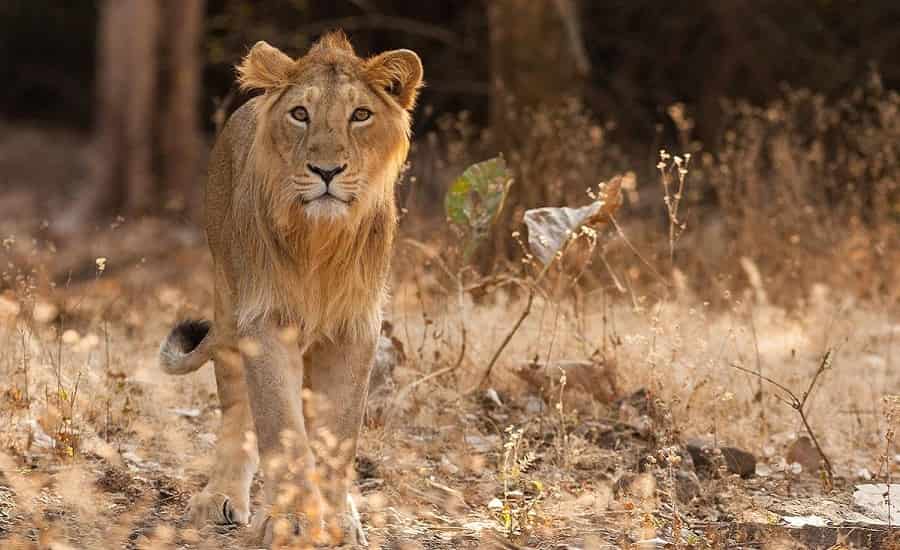
Day 8: Gir Lion Sanctuary
Morning and evening drives in an open-topped 4-wheel drive vehicles in Gir. Overnight at the lodge.
Day 9: Gir Lion Sanctuary
Morning and evening safari drives in an open-topped 4-wheel drive vehicle in Gir. Overnight at the lodge.
Day 10: Sasan – Palitana (Approx 5 hours drive)
Highlights: Sites along the Gulf of Cambay
Morning drive at Devaliya. This zone of Gir is more open and has good chances of seeing harriers and grassland passerines. After breakfast, depart for Palitana to reach there in time for lunch at Vijay Vilas, a Heritage Hotel. Visit Bhavnagar, one hour east, to watch birds at various sites. Top-sites are Victoria Park, where Marshal’s and Common Iora, Paradise Flycatcher, White-browed and White-spotted Fantails, treepies, etc are likely to be seen. At the nearby wetlands, Pill Gardens, Painted Storks breed in good numbers at the city-centre park and at coastal areas where Reef Egret also breed in good numbers. Overnight at Vijay Vilas.
Day 11: Palitana – Velavadar National Park – Ahmedabad (Approx six hours drive + time at Velavadar)
Highlights: Velavadar National Park
Morning optional visit to the Jain temples of Palitana, a cluster of about 800 temples on a hilltop. Or you can bird around Palitana. Depart after lunch for Velavadar National Park where large herds of Blackbuck and Blue Bull Antelope sightings are guaranteed and wolf, Indian Fox, Jackal, Jungle Cat and Black-naped Hare are possible. Stoliczka’s Bushchat, Crested and Rufous-tailed Larks, shrikes, wheatears, Red-rumped Swallows are key species and in the evening large number of harriers, mainly Montagu’s, can be seen coming in to roost. Continue after sunset to Ahmedabad, a three hour drive, to reach there in time for late-dinner and overnight stay at the House of Mangaldas, a Heritage Hotel.
Day 12: Around Ahmedabad
Highlights: Nalsarovar and Thol Bird Sanctuaries.
Full day tour of Nalsarovar Bird Sanctuary and other wetlands around Ahmedabad with packed lunch. Besides waterfowl, these wetlands are good for Marsh Harrier and Aquila Eagles. Return at night for an authentic Gujarati dinner served on silver platters (thalis).
Day 13: Ahmedabad – Delhi / Dep.
Morning at leisure & flight to Delhi. Upon arrival transfer to Delhi International Airport for onward flights.
